Monday, October 30, 2006
THE CRYPT AND SCARY STORIES
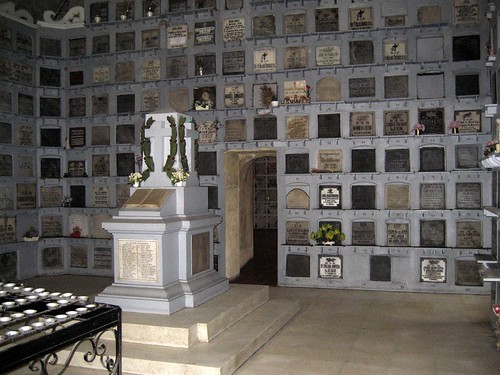
Located within the San Agustin Church complex, the crypt, formerly called the De Profundis Hall, was where the friars recited the psalm for their fellow brothers and the benefactors of the Community as they left the Refectory. It is also here in which the remains of Juan Luna, Pedro Paterno, Pedro de Tavera, and many others are interred. During the British occupation of Manila (1762-1764), all gravesites like this one — and most especially those of the Spanish conquistadors — were desecrated by the invading forces and ransacked of valuables.
The crypt was also used as prison and execution grounds during the Battle of Manila in 1945. The monument at the center marks the tomb of 141 prisoners of war who were executed by the Japanese in the last few days of the occupation of Manila during World War II.
The crypt was one of the historical places included in the itinerary of Carlos Celdran’s walking tour of Intramuros. However, I was disappointed when throughout the entire tour of this historical complex that dates back many centuries, there was no mention of even a single ghost story. But on his other walking tour — Philippine Cultural Center — Carlos dispelled the rumors of ghosts that haunt the cultural complex on account of several workers having lost their lives during an accident caused by its frenetic construction schedule.
I am not one of those prone to witness ghostly apparitions — I guess there is a rule of conduct in the spirit world that forbids making one’s presence tangible to those gravely petrified of it. I could, however, sense an eerie presence; last experience I had of which happened in an uncle’s leased house inside the old naval base in Subic. A couple of minutes after I had turned off the light in the bedroom, I began to sense another presence inside the room besides myself. I don’t remember how long it took me to finally fall asleep, but I never spent another night in that house.
The same experience I had in my cousin’s leased house inside the old naval base. But in this instance, the caretaker did admit the following morning that there are indeed ghost sightings inside that house. There was even one that would occur in the middle of the day — a naked young boy of about three would come giggling and running inside the house, and just as suddenly disappear inside. It used to startle her in the beginning but she eventually got used to it and just ignores its reoccurrences.
There is a common belief here in the Philippines that houses rarely used or has not been resided in a long time tend to be inhabited by spirits, which is just as common an occurrence with the living — professional squatters who will occupy and build shanties in vacant lots.
Anyway, come Halloween and All Soul’s Day, ghost stories will abound at nightfall. And most certainly, everyone has a scary story to share with anyone dying to hear it.
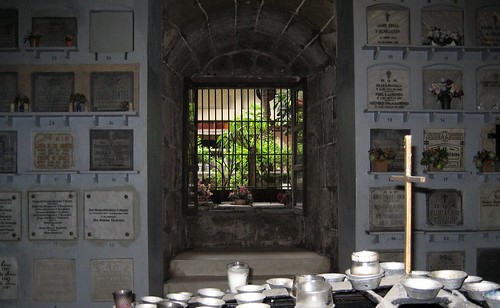
posted by Señor Enrique at 4:15 PM
| 14 comments
![]()
![]()

Sunday, October 29, 2006
THE CHINESE CEMETERY
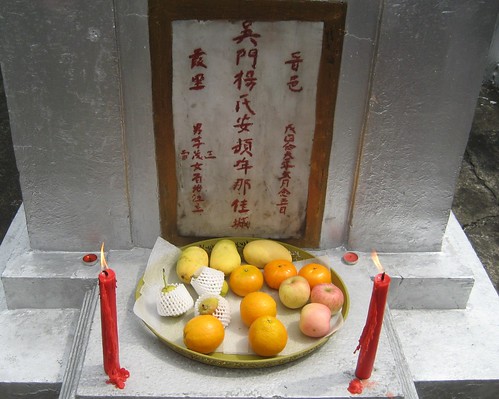 When we were young, spending the weekend in Subic sometimes entailed taking a jeepney to Victory Liner bus terminal in Rizal Avenue in Grace Park. And whenever we’d pass by the Chinese Cemetery, an older cousin would remark that if I were hungry and wanted some free food, all I had to do was go inside this cemetery and feast on the foods left as offerings for the dead by their grieving loved ones. He claimed there were lots of siopao, tikoy, pancit, fried chicken, fruits, and many assorted baked goods to be found inside that cemetery at any time of the week. I was intrigued. I knew well enough that the dead couldn’t possibly consume any of that food, but I wanted to know who really ended up enjoying those delectable offerings.
When we were young, spending the weekend in Subic sometimes entailed taking a jeepney to Victory Liner bus terminal in Rizal Avenue in Grace Park. And whenever we’d pass by the Chinese Cemetery, an older cousin would remark that if I were hungry and wanted some free food, all I had to do was go inside this cemetery and feast on the foods left as offerings for the dead by their grieving loved ones. He claimed there were lots of siopao, tikoy, pancit, fried chicken, fruits, and many assorted baked goods to be found inside that cemetery at any time of the week. I was intrigued. I knew well enough that the dead couldn’t possibly consume any of that food, but I wanted to know who really ended up enjoying those delectable offerings.Interestingly, this image of abundant foods inside the Chinese Cemetery, whether true or mythical, remained etched in my memory that when Ivan advised me of the walking tour he was conducting inside this cemetery this Saturday, I immediately signed up.
And my older cousin was, indeed, right! There were numerous food offerings everywhere, especially now that many people are beginning to visit their respective family gravesite for the upcoming All Soul’s Day. However, when I asked two elderly women, who were sisters, if they would just leave behind their food offering when they leave to go home, I was disappointed to hear a no. They planned, as usual, to give them to their caretakers. As if to erase the puzzled look on my face, one of them quickly added, “No one does that,” she exclaimed, “otherwise, this place would’ve become a breeding ground for all sorts of vermin!” My older cousin, after all, turned out to be only half-right.
 The Chinese Cemetery is part of the three-cemetery complex of Manila; namely: La Loma, North and Chinese. During the nineteenth-century, only the Catholics were allowed to be interred in La Loma. The paupers, non-Christians, victims of communicable diseases, and enemies of the colonial government were relegated to the Chinese Cemetery for burial.
The Chinese Cemetery is part of the three-cemetery complex of Manila; namely: La Loma, North and Chinese. During the nineteenth-century, only the Catholics were allowed to be interred in La Loma. The paupers, non-Christians, victims of communicable diseases, and enemies of the colonial government were relegated to the Chinese Cemetery for burial.Apparently, one of our national heroes, Apolinario Mabini, met three of the aforementioned criteria: he was a Mason; hence, a non-Christian; he suffered from cholera; and his insurgent writings deemed him enemy of the state. And so upon his death on May 13, 1903, he was buried in the Chinese Cemetery; however, his remains were later transferred to his hometown to a permanent gravesite. The pyramid-shaped monument (a significant icon to Masons) now stands on the original site of his resting place at the Chinese Cemetery.
 One cannot just buy a burial plot outright at the Chinese Cemetery; it can only be leased for twenty five years. However, if one had achieved exemplary accomplishments in life — toward the betterment of the community while living, for example — he could be rewarded with a burial site for free as in the mausoleum for Chinese martyrs (above photo). The colorful ribbons signify a recent visit made by family members or friends.
One cannot just buy a burial plot outright at the Chinese Cemetery; it can only be leased for twenty five years. However, if one had achieved exemplary accomplishments in life — toward the betterment of the community while living, for example — he could be rewarded with a burial site for free as in the mausoleum for Chinese martyrs (above photo). The colorful ribbons signify a recent visit made by family members or friends.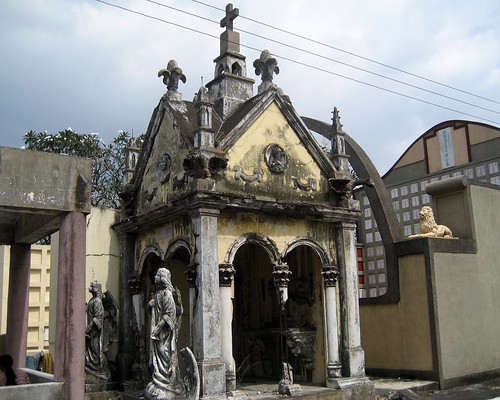 For those families unable to afford a continuance of the lease once due for renewal, they are no longer allowed to do any more maintenance work on their respective grave site or mausoleum. However, the cemetery administrators will not evict the buried by digging up and disposing the remains, because they might only attract bad luck into their life. Instead, a gravesite or mausoleum will be left untouched to decay with time (as in the above photo) until the family itself makes the necessary arrangements to remove and transfer the remains of their loved ones to another tomb somewhere.
For those families unable to afford a continuance of the lease once due for renewal, they are no longer allowed to do any more maintenance work on their respective grave site or mausoleum. However, the cemetery administrators will not evict the buried by digging up and disposing the remains, because they might only attract bad luck into their life. Instead, a gravesite or mausoleum will be left untouched to decay with time (as in the above photo) until the family itself makes the necessary arrangements to remove and transfer the remains of their loved ones to another tomb somewhere.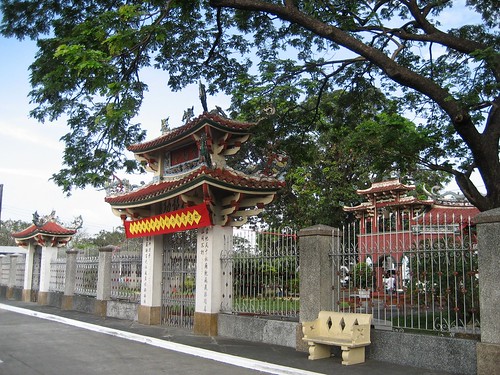 The Chinese Cemetery is only a few minutes from where I live. Having joined this tour, I discovered a nice spot that I can return to whenever I needed a respite from the hustle and bustle of city living — to bring a lounge chair and read a book or just meditate and get lost in space, so to speak. Inside the courtyard of the Chong Hock Tong Temple would be an ideal setting for such activity (above photo). It is supposedly one of the oldest temples in the country.
The Chinese Cemetery is only a few minutes from where I live. Having joined this tour, I discovered a nice spot that I can return to whenever I needed a respite from the hustle and bustle of city living — to bring a lounge chair and read a book or just meditate and get lost in space, so to speak. Inside the courtyard of the Chong Hock Tong Temple would be an ideal setting for such activity (above photo). It is supposedly one of the oldest temples in the country.The Chinese Cemetery boasts some of the most incredible mausoleums in the entire Philippines as in the following photos:
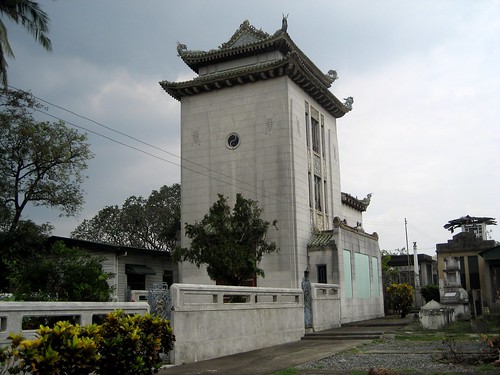 The three-storey mausoleum owned by Dee C. Chuan, son of a lumber magnate and founder of the first Chinese-owned bank in the Philippines, China Bank. Inside hanging against the main wall is the life-size oil painting of Chuan and his wife; rumored to have been done by Amorsolo. A separate cottage beside this mausoleum in the same tract of land is a fully-furnished rest house for family members and guests. It has a living room, bedrooms, bathroom, and just about every necessary feature of a comfortable family dwelling.
The three-storey mausoleum owned by Dee C. Chuan, son of a lumber magnate and founder of the first Chinese-owned bank in the Philippines, China Bank. Inside hanging against the main wall is the life-size oil painting of Chuan and his wife; rumored to have been done by Amorsolo. A separate cottage beside this mausoleum in the same tract of land is a fully-furnished rest house for family members and guests. It has a living room, bedrooms, bathroom, and just about every necessary feature of a comfortable family dwelling.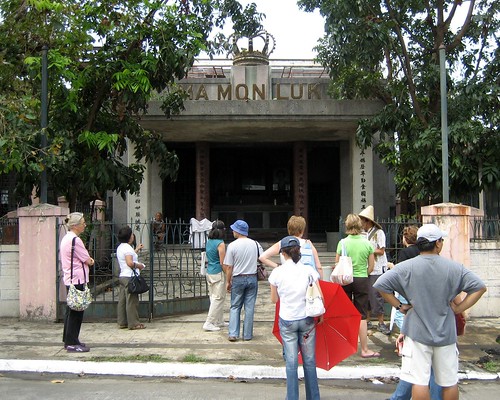 This mausoleum with a huge crown on its top belongs to the king of mami (noodle soup), Ma Mon Luk. His two wives are also buried here on either side of him. Ma Mon Luk was a master salesman, showman, and hopeless romantic; his was a life worthy of a telenovela (soap opera). At least three Ma Mon Luk restaurants I know of are still operational in Binondo, Quiapo and Quezon City near Banawe Street.
This mausoleum with a huge crown on its top belongs to the king of mami (noodle soup), Ma Mon Luk. His two wives are also buried here on either side of him. Ma Mon Luk was a master salesman, showman, and hopeless romantic; his was a life worthy of a telenovela (soap opera). At least three Ma Mon Luk restaurants I know of are still operational in Binondo, Quiapo and Quezon City near Banawe Street.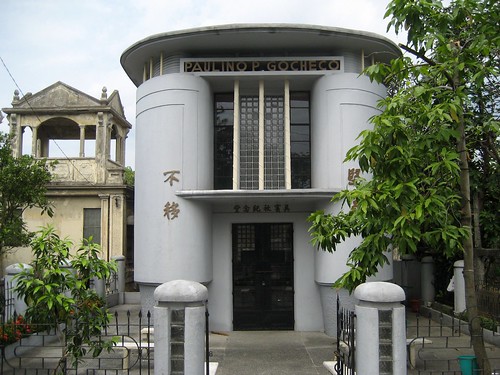 This Art Deco-inspired mausoleum built by the Gochengco Family typifies the American colonial influence even in the architecture of a family resting place. There are larger and even more elaborate ones, though not as well-maintained as this one.
This Art Deco-inspired mausoleum built by the Gochengco Family typifies the American colonial influence even in the architecture of a family resting place. There are larger and even more elaborate ones, though not as well-maintained as this one.As they say, it takes money to build a dream house and so does it take money to maintain it through the years. In this cemetery, a certain Chinese family can further flaunt their wealth through the manner in which their mausoleum is maintained year-round.
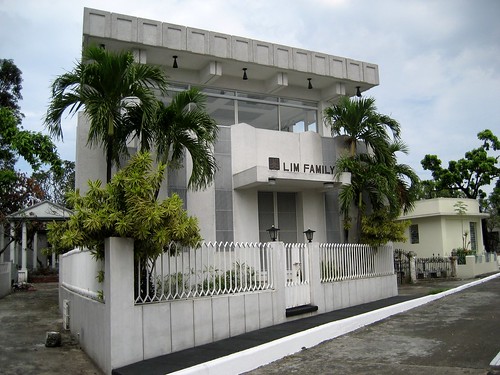 There are also ultra modern mausoleums as this one built by the Lim Family. This reminds me of the contemporary summer houses in the Hamptons in Long Island, New York and in Venice Beach in Los Angeles. Among the mausoleums with modern architecture in the Chinese Cemetery, this one is by far the best designed.
There are also ultra modern mausoleums as this one built by the Lim Family. This reminds me of the contemporary summer houses in the Hamptons in Long Island, New York and in Venice Beach in Los Angeles. Among the mausoleums with modern architecture in the Chinese Cemetery, this one is by far the best designed.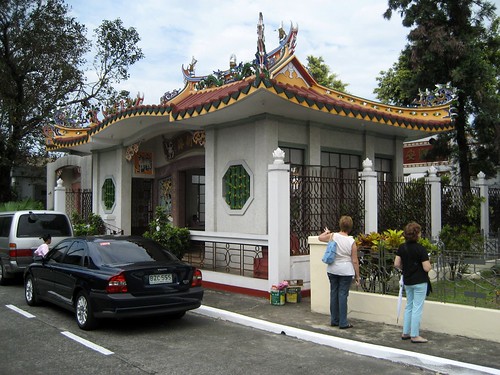 This is, undoubtedly, my personal favorite mausoleum in the entire cemetery. I like it neither because of its whimsical pagoda-inspired architecture nor for the owner’s choice of a European sports sedan. I like it simply because it is the mausoleum with the most bountiful and festive food offering (see photo below).
This is, undoubtedly, my personal favorite mausoleum in the entire cemetery. I like it neither because of its whimsical pagoda-inspired architecture nor for the owner’s choice of a European sports sedan. I like it simply because it is the mausoleum with the most bountiful and festive food offering (see photo below).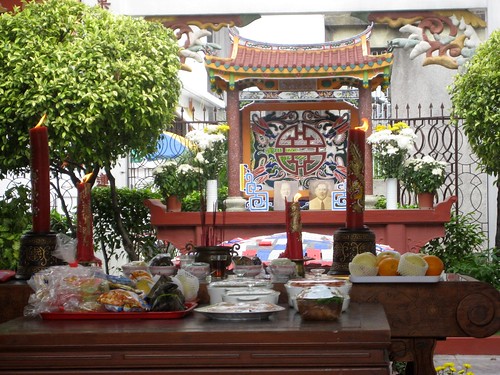 There are far too many interesting gravesites, mausoleums, and monuments in this history-rich Chinese Cemetery that this entry can possibly cover. The stunning interiors of some these mausoleums are also worth featuring extensively. Although a series of blog entries or a dedicated site might do the job, there’s still nothing even more exciting than to actually experience the walking tour itself — to see every point of interest of this so-called city of the dead while Ivan masterfully provides the accompanying history lessons.
There are far too many interesting gravesites, mausoleums, and monuments in this history-rich Chinese Cemetery that this entry can possibly cover. The stunning interiors of some these mausoleums are also worth featuring extensively. Although a series of blog entries or a dedicated site might do the job, there’s still nothing even more exciting than to actually experience the walking tour itself — to see every point of interest of this so-called city of the dead while Ivan masterfully provides the accompanying history lessons. Ivan’s Mounds, Magnates and Mausoleum walking tour this Saturday was for the benefit the Museum Foundation of the Philippines. Besides enjoying the tour, had the pleasure of meeting some fellow members, including its executive director, Tricia Limon.
Ivan’s Mounds, Magnates and Mausoleum walking tour this Saturday was for the benefit the Museum Foundation of the Philippines. Besides enjoying the tour, had the pleasure of meeting some fellow members, including its executive director, Tricia Limon.Ivan's Old Manila Tours
Telephone: 711-3832
Cellphone: 0917-329-1622
Email: oldmanilawalks@gmail.com
posted by Señor Enrique at 11:47 AM
| 23 comments
![]()
![]()

Friday, October 27, 2006
KEEPING ONE'S COOL
 One of the exhibitors at the 21st Negros Trade Fair held in Rockwell last September was Casa Mercedes, makers of folding fans (featured in this top photo). These fans of various designs and colors have been exquisitely created with fine quality materials; giving those made in Spain a run for their money.
One of the exhibitors at the 21st Negros Trade Fair held in Rockwell last September was Casa Mercedes, makers of folding fans (featured in this top photo). These fans of various designs and colors have been exquisitely created with fine quality materials; giving those made in Spain a run for their money.Casa Mercedes also produces a line of folding fans for men, which are larger than those for women. The saleslady informed me that they do a brisk business with their men’s collection, especially for export to Europe. I bought one in black for myself, and before heading out of the fair, I decided to go back to the Casa Mercedes booth to get a couple of more fans for men to send to my brothers in New York. Unfortunately, they were all sold out. The saleslady told me that a group of Chinese women bought the rest of their stock for their husbands and friends.
The folding fans in the picture at the very bottom are of the cheapest kind; usually sold near the churches for no more than twenty pesos. Made with less than durable materials, they don’t last that long. They’re about as good as those cheap folding umbrellas from China.
 Since I moved to Manila, I always carry an anahaw fan (similar to the ones in the photo on the left, but in plain color). It’s not only good for what it is, but it’s effective as well as a shield against the hot sun or a light drizzle. Just ask Sidney. I’m sure he got a kick when he saw me pull out my large anahaw fan from my bag during our Binondo walking tour with Ivan.
Since I moved to Manila, I always carry an anahaw fan (similar to the ones in the photo on the left, but in plain color). It’s not only good for what it is, but it’s effective as well as a shield against the hot sun or a light drizzle. Just ask Sidney. I’m sure he got a kick when he saw me pull out my large anahaw fan from my bag during our Binondo walking tour with Ivan.About four years ago, the only ones who use a folding fan besides the women were gay teens and gay men. However, nowadays, a lot of straight guys — from high school students to businessmen — can be seen with a folding fan in public instead of using a notebook or a manila envelope. And since folding fans can be easily stashed in brief bags or back packs, they have since gained further public acceptance as a necessary accessory for both men and women, especially during the hot summer months.
Personally, I’d rather stay dry and comfortable than get soaked in sweat. Thus, I always carry a fan in my bag — either the large anahaw fan or a folding fan — to use when needed despite how others might perceive or discount my masculinity. Same as with an umbrella; I never ventured outside without one whenever it was raining or about to rain.
Speaking of conveyed messages through one’s accessories, during the more prudish era under the Spanish regime, the folding fan and another must-have accessory, the handkerchief, were also effective means of communication for women in the affairs of courtship. The entire vocabulary was simple, silent, and discreet.
As Ambeth Ocampo cited, in the nineteenth-century, courtship was extremely an arduous undertaking, because women were born and raised to be one of only three things: nun (to serve God), housewife (to serve a man) or spinster (to serve her family). It was also difficult for a man to meet a woman, unless he was fully accepted and welcomed by the woman’s parents.
At social gatherings, the women were usually seated at one side and the men on the other. The most a man would get from a woman he desired were shy smiles or monosyllabic responses, lest she seemed too “easy.” If the man was lucky enough to know someone close enough to the woman, then he would be used as a “bridge;” without which, a fan or handkerchief would be the next best thing.
Here’s a sampling of the signals and their corresponding meaning according to The Prewar Lovers’ Guide by Ambeth Ocampo:
Through a handkerchief:
Brush against the lips = I’d like to exchange letters
Brush against one eye = I feel a sense of sadness
Brush against the left hand = I think I like you
Brush against both cheeks = I love you
Let if fall = Let’s get to know one another
Press against the right cheek = Yes
Press against the left cheek = No
Brush against the shoulder = Follow me
Fold = I’d like to speak with you
Fold the ends = Wait for me
Twist with both hands = It matters not
Twist with right hand = I love someone else
Twist with left hand = I don’t want to meddle in your affairs
Tie against the index finger = I have another sweetheart
Tie against the ring finger = I am married
Tie against entire hand = I am yours
Play with the handkerchief = I care not for you
Through a fan:
Carry it dangling from the right hand = I’d like to have a boyfriend
Carry it dangling from the left hand = I already have a boyfriend
Fan constantly = I love you a lot
Fan slowly = You don’t mean anything to me
Fold suddenly = I like you
Let it fall = My aim is true
Cover half the face = Follow me
To not carry or hide in one’s pocket = I am not interested in your courtship
Nowadays, courtship is much easier, especially since the advent of cellphones and text messaging. There’s also the Internet (emails, chat rooms, instant messages, Friendster and My Space). It is now also an acceptable norm for a woman to initiate and pursue a man she desires. And for those intrepid lovers unable to curtail their urges, the fans and handkerchiefs have become even more necessary accessories — but this time for their original purpose — especially after a torrid rendezvous in one of those cheap motels without air-conditioning that abound in Manila’s university belt area.
 Additional sources:
Additional sources:Breakfast with Aguinaldo - And More Looking Back Essays
By Ambeth Ocampo
Anvil Publishing
Casa Mercedes, Inc.
148 G. Reyes Street, San Juan, Metro Manila
Telephone: 724-3846
Email: casamerc@unfo.com.ph
posted by Señor Enrique at 11:39 AM
| 12 comments
![]()
![]()

Thursday, October 26, 2006
HERB FOR THE NERVE
 Here in the Philippines, a drug arrest — possession, use, or distribution of which — ranks as among the toughest offense to beat; not to mention that a defendant cannot secure temporary release because in such cases, no provision to post bail exists.
Here in the Philippines, a drug arrest — possession, use, or distribution of which — ranks as among the toughest offense to beat; not to mention that a defendant cannot secure temporary release because in such cases, no provision to post bail exists.The justice system had also done away with meting out a trip to the rehab as the usual punishment for those convicted of drug use.
Legislators had finally realized that no court of law can ever make a drug user kick his habit; unless, of course, the addict himself admits he has a problem and is completely willing to rid himself of it. Armed with such insight, nowadays, even a moderate marijuana user who gets caught with minimal amount could face at least two years locked behind bars.
Local prison jargon refers to drug users as "section five offenders;" whereas, "section eleven offenders" are those caught with substantial amount with intention to distribute — applicable to drug lords -- smugglers or producers of shabu (crystal meth or methamphetamine). Those charged with a section eleven offense would oftentimes claim being users also; hence, if classified as "five-eleven offenders," they could stand a chance to receive lesser penalties. They could, in effect, seek mercy from the court by claiming they sold drugs to sustain their habit.
Typically, section eleven and eleven-five offenders receive sentences of 30-to-48 years, 40-to-60 years, or life.
An offender would often languish for many months in one of the city jails before he sees his day in court; years before he sees its final conclusion. Hence, someone whose case got dismissed or found not guilty could have still wasted some precious years incarcerated in a city jail. Those found guilty will be transferred to a maximum security facility as in Muntinlupa.
The use of mind-expanding and/or sedative drugs is not exclusively a modern day phenomenon in the Philippine archipelago. It has been part of the local landscape since the Spanish regime. In fact, even Jose Rizal painted one of his prominent characters of Noli Me Tangere as having spent his final years as a drug addict.
Once a wealthy and powerful man, this particular character had later become feebly, jaundiced and grungy; spending the daytime sitting by the sidewalk and staring mindlessly at nothing in particular — totally lost in space. In the evenings, he could be seen leaning on his cane as he walked toward a filthy, narrow alley that leads to the door of Anfion Public Smoking Den. Don Santiago de los Santos, otherwise known as Capitan Tiago, a once respected gobernadorcillo and father of Maria Clara, spent the final years of his life suffering from a serious opium addiction.
Although Capitan Tiago is a mere fictional character, opium dens, however, legally existed in Manila during the nineteenth-century. Opium was controlled by the government, and a source of great revenues — tariffs, license fees, opium farming, and etc. And this may be the reason why the powerful Chinese merchant Carlos Palanca approached Emilio Aguinaldo and enticed him into creating an opium monopoly.
 Anfion was the name given to opium which was compounded and prepared for smoking; however, only the Chinese were permitted to smoke it in licensed public smoking dens.
Anfion was the name given to opium which was compounded and prepared for smoking; however, only the Chinese were permitted to smoke it in licensed public smoking dens. For the most part, it was the affluent members of the Chinese community who indulged in this vice and patronized these opium dens. There were also some Filipinos and mestizos who engaged in its use and risked getting apprehended. Unarguably, opium trade in the Philippines had provided the Spanish with a lucrative revenue stream, but when the Americans took over, their altruistic intention for the Philippines became of greater importance. In the culture of prohibition — which was also a strong and growing trend in America by 1898 — complete eradication was the only opium policy for a U.S. colony.
The U.S. argument was simple: opium smoking is unhealthy and immoral. And with the U.S. intention to improve the lives of Filipinos, its policy must therefore oppose opium smoking from the beginning.
However, there was a certain irony in this colonial prohibition policy, because at that time, opium remained a legal commodity in America throughout the period of 1898-1910. Subsequently, a more stringent law against opium in the U.S. was created and passed — the Harrison Narcotic Act.
Most American addicts in the nineteenth-century were middle-class white women and, to a lesser extent, Civil War veterans. The former took — not smoked — opium as a more discreet and socially acceptable antidote (than alcohol) when dealing with life’s daily stress. The latter consumed opium to assuage their pain from old war wounds. Most of these addicts took opium in tonic or powdered form rather than smoked it, a common means of consumption among ethnic Chinese the world over.
However, opium addiction in America eventually spread to other ethnic groups, including African Americans and ethnic Chinese. Opium also began to affect the lower classes when a derivative was developed from which — heroin. Thus, prohibition campaigns grew stronger out of fear that these new addicts would become susceptible to committing crimes, as well as generally disrupt society to fulfill their drug addiction; an image of addicts that is now a familiar one.
But in the Philippines, under Spanish law, the Filipinos were forbidden to purchase and smoke opium; in some part because of their poverty. By continuing similar preventive measures, American colonial officials would certainly demonstrate their benevolent intentions to improve the country and its inhabitants. Ironically, the primary opium users in the Philippines were the most hard-working, powerful, and wealthy Chinese businessmen; definitely not prone to laziness and not likely to commit violent crimes. Nonetheless, U.S. legislators pursued a general prohibition policy in the Philippines with the hope that the whole ethnic Chinese problem, as they deemed it, would literally go away.
In the end — unlike in European colonies in Asia — U.S. officials successfully prevented a potential opium dependency among the populace by finally outlawing opium altogether throughout the Philippine archipelago. However, smuggling of it by the Chinese ensued in which the Americans failed to eradicate altogether. The coastal waters that surround the Philippine archipelago proved impossible for the U.S. ships to monitor.
At present, the smuggling and distribution of illegal drugs, as well as addiction to it, continue to be a major problem in the archipelago.
Despite stringent laws and stiffer penalties, the lure of big money to be made from its traffic, including the promise of temporary solace derived from its use, are elements much too powerful for many to resist..
 Additional sources:
Additional sources:Noli Me Tangere by Jose Rizal
As translated in English by Maria Soledad Lacson-Locsin
Published by Bookmark, Inc.
The American Colonial State in the Philippines - Global Perspectives
Julianne Go and Anne L. Foster, editors
Anvil Publishing, Inc.
Vintage photo credit:
Opium den, Malinta Street, Manila, early 1900s
U.S. Library of Congress / Philippines Image Collection
Labels: Manila history
posted by Señor Enrique at 12:13 PM
| 15 comments
![]()
![]()

Wednesday, October 25, 2006
PINNED
 I was in Palanca Street in Quiapo this Monday when I came upon this sight. I knew something like this is bound to happen — a pedicab going against the flow of traffic on a busy narrow street of Manila — and causing an adverse incident.
I was in Palanca Street in Quiapo this Monday when I came upon this sight. I knew something like this is bound to happen — a pedicab going against the flow of traffic on a busy narrow street of Manila — and causing an adverse incident. This pedicab driver, despite knowing he had no other place to go, insisted on inching forward and thereby getting pinned when the bus finally had to move forward as well. Fortunately, it wasn’t a bumper-to-bumper situation; giving the driver enough leeway to back up and maneuver his bus away from the pinned pedicab.
Lately, a growing number of pedicabs and tricycles are noticeably going though one way streets but against its designated traffic flow. One evening, at Oroquieta Street (a one way street heading to Blumentritt), I passed a jeepney that was ahead of me (that had stopped to pick up a passenger) when suddenly a pedicab appeared in front of me. Luckily, I wasn’t going fast and able to apply the brakes just in time to avoid hitting it head on. However, had there been another vehicle right behind me, it surely would have crashed against my car for my having stopped so suddenly.
In another occasion, I was waiting for the light when a pedicab suddenly hit my back bumper. It was scratched and would cost at least P1000 to get fixed. I knew the pedicab driver had no money to pay for the repair so I just let it go.
I realize that because of hard times, some less fortunate folks have to do what they can to make a living or maximize their earning capabilities. But then again, I don’t believe that being financially-strapped gives them or anyone else the license to be excused from adhering to law and order.

posted by Señor Enrique at 11:12 AM
| 20 comments
![]()
![]()

Sunday, October 22, 2006
THE DAY WITH A CUCHERO
 The other day, with nothing else better to do after having lunch in Chinatown near Binondo Church, I flagged down a calesa (a two-wheel horse-drawn carriage) for a ride to Tutuban Mall in Divisoria. The cuchero (rig driver) charged forty pesos for both me and my nephew; a reasonable enough fare since the uncomfortable pedicab ride would cost about thirty pesos.
The other day, with nothing else better to do after having lunch in Chinatown near Binondo Church, I flagged down a calesa (a two-wheel horse-drawn carriage) for a ride to Tutuban Mall in Divisoria. The cuchero (rig driver) charged forty pesos for both me and my nephew; a reasonable enough fare since the uncomfortable pedicab ride would cost about thirty pesos.I love riding on calesas and often take one whenever the opportunity presents itself. The cuchero of this particular calesa claimed he has been doing it for more than thirty years. It is a family enterprise he said in which he is also responsible for training the young drivers and horses from Batangas. The black horse (in photo above) he has been training/handling for the past four months. This horse is acclimating quite well with the city traffic. Only problem is it has pretty acute hearing and gets easily spooked by sudden bursts of loud noises. As a remedy, this veteran cuchero puts earmuffs on the horse; starting with a thick version and gradually decreasing the thickness as the horse gets adjusted to various street noises.
Soon he’ll assign this black horse to one of the cucheros in the family’s employ. He will then take on a new young horse to train. This man does seem to have done a pretty good job since the horse was noticeably obedient of his every command; not once did the cuchero have to resort to the whip. He also spoke of the perils involved in driving a calesa nowadays due to myriad traffic snarls and impatient motorists; hence, his job also entails the training of the young cucheros to become ever mindful of their horses’ safety in various traffic conditions.
Now, here’s a man who appears to have a very responsible and professional attitude toward his occupation. Furthermore, in the many years he has been doing it, he has never caused any harm to any of his horses, passengers, pedestrians, or motorists. Neither has he gotten in any serious trouble with traffic enforcement officers. This man was definitely unlike Rizal’s cuchero in El Filibusterismo who caused his passenger, Basilio, much delay when he was stopped and detained by the guardia civil for having forgotten to carry his cedula (identity card) in his person. Although it was his fault, he was nevertheless embittered for getting hit with some rifle butts and dragged to the barracks to face the commandant.
When released, there was another delay he and his passenger had to endure — a Christmas Eve procession. While waiting for the procession to pass, he asked Basilio, if the mythical king of the indios had almost escaped from the chains that imprisoned him, for his eventual freedom would rid the country of the guardia civil that he hated so much for hurling abuse at him and hitting him with rifle butts for his every infraction. He pledged to offer his horse and meager possessions to the king for that day when the king would save him from such unmerciful acts by the guardia civil.
After the procession had finally passed, the cuchero was stopped a second time that evening by another guardia civil. This time, it was because the rig’s light had gone out. A rain of insults fell upon the poor cuchero who tried in vain to explain that the procession had lasted too long; making his rig’s light burn out its entire fuel.
As I delve more into our local history, the more I am led to believe that Rizal’s two novels — Noli Me Tangere and El Filibusterismo — were not simply a scathing indictment against the abuses of the friars, but also an exposure of the Filipino frailties; in this case, the incompetence and lack of spiritual maturity as demonstrated by this cuchero. Leaving his identity card at home and not carrying an extra supply of fuel for his rig’s light were enough to prove his incompetence. Moreover, instead of looking inward to correct his erroneous ways, this cuchero would rather pin his hope of deliverance from the cruelty of the guardia civil on some mythical king.
Had he been more mindful of his responsibilities, he could have been more vigilant to carry his identity card with him at all times, as well as carry an extra supply of oil for his rig’s lamp. In so doing, he would have prevented getting arrested, hit with rifle butts, or verbally abused by the more competent guardia civil who perform their duty more diligently.
Ironically, in today’s Metro Manila, it’s common to see the exhaust pipes of some commuter buses and jeepneys belching out black smoke; drivers deliberately dropping off and picking up passengers in prohibited areas and entangling traffic in the process; drivers who commandeer their private vehicles in city traffic as if no one else matters in the world but them; and, of course, those swarm of students in the university belt area who would cross the street regardless whether the light is in their favor or not. Yet, everyone is quick to claim innocence when caught by traffic enforcement officers, or even whisper that such apprehension is nothing more than a rouse to fish out some merienda money.
Alas! Despite these modern times, there are still those who’d choose to remain incompetent and immature in their ways as Rizal’s cuchero.

posted by Señor Enrique at 1:20 PM
| 19 comments
![]()
![]()

Friday, October 20, 2006
THE BRUNEI CONNECTION
 One of the fun moments of my having attended the international book fair — held last September in Metro Manila’s World Trade Center — besides discovering titles galore under one roof, was meeting new people like those folks from Brunei.
One of the fun moments of my having attended the international book fair — held last September in Metro Manila’s World Trade Center — besides discovering titles galore under one roof, was meeting new people like those folks from Brunei.Their booth carried some fine coffee table books on travel and culture. In jest, told them that Brunei is so rich they needn’t sell their books; they ought to just give them away. Much to my surprise, when I purchased one of their children’s illustrated storybook for a niece’s daughter, they handed me as gifts a couple of travel guides; featuring beautifully photographed landscapes and all sorts of points of interest. These glossy four-color giveaway booklets were printed on high quality paper; evidence of the well-endowed coffer of Brunei’s culture and tourism ministry.
Regrettably, one of the books I had also purchased at the fair on that day, Sonia Zaide’s The Philippines – A Unique Nation, I wish I had owned and read beforehand, because mentioned in it was an historic event connected to Brunei. This would have made an interesting discussion with these friendly folks from the Brunei Darussalam booth. I’m sure it would’ve astonished them to learn that Brunei once shared close historical links with the Philippines than realized.
One of these events was the Tondo Conspiracy of 1587-88.
Comprised of very prominent Filipinos whose intention was to overthrow the Spanish rule and regain the freedom it once enjoyed. Its mastermind was Agustin de Legazpi; nephew of Lakan Dula and son-in-law of the sultan of Brunei. His first cousin was Martin Pangan, who was then the gobernadorcillo of Tondo.
Besides these two, the other major players in this Tondo Conspiracy were Magat Salamat, son of Lakan Dula and Chief of Tondo; Juan Banal, another Tondo chief and Salamat’s brother-in-law; Geronimo Basi and Gabriel Tuambacar, brothers of Agustin de Legazpi; Pedro Balinguit, chief of Pandacan; Felipe Salonga, chief of Polo; Dionisio Capolo (Kapulong), chief of Candaba and brother of Felipe Salonga; Juan Basi, chief of Taguig; Esteban Taes (Tasi), chief of Bulacan; Felipe Salalila, chief of Misil; Agustin Manuguit, son of Felipe Salalila; Luis Amanicaloa, chief of Tondo; Felipe Amarlangagui, chief of Caranglan; Omaghicon, chief of Navotas and Pitongatan, chief of Tondo.
Augustin de Legazpi had made contact with a Japanese sea captain, Juan Gayo, through a Japanese Christian and interpreter, Dionisio Fernandez, who had also joined the conspiracy. A secret agreement was concluded in which Captain Gayo would supply arms and Japanese warriors to help the Filipino rebellion and recognize Augustin de Legazpi as king of the Philippine kingdom. In reciprocity, Captain Gayo and the Japanese warriors would receive one-half of the tribute to be collected in the Philippines.
Besides this Japanese connection, there were other secret meetings that had to be concluded before the final plan of the uprising was to become completely enforceable. First, a secret delegation would travel to Borneo to secure combat troops and ships from the Sultan of Brunei. Second, obtain the support and participation of the inhabitants of Laguna and Batangas in this struggle for freedom. Once a full commitment was received from Borneo, Batangas and Laguna, the armed rebellion would begin upon the arrival at the Manila Bay of the Sultan of Brunei’s warships with warriors on board. The conspirators and their armed warriors would then launch a ferocious attack to completely annihilate the Spaniards and then set the city on fire.
It would have been a good plan climaxed by an epic battle had it not been for a turncoat who betrayed the conspiracy and reported it to the Spanish authorities.
On the way to meet with the Sultan of Brunei, Magat Salamat, Juan Banal, and Augustin Manuguit stopped at Cuyo, Calamianes, to meet with its native chief, Sumaclob. The chief was swayed to join the conspiracy and pledge to contribute 2,000 of his men for the cause. However, Magat Salamat made an error in judgment by soliciting the participation of another Cuyo native, Antonio Surabao. Upon learning of the secret plan, Surabao rushed to expose it to his master, Captain Pedro Sarmiento, the Spanish encomendero of Calamianes. And once Salamat, Banal and Manuguit were apprehended, Captain Sarmiento hastily traveled to Manila and informed Governor Santiago de Vera on October 26, 1588 of a brewing conspiracy against Spanish rule.
The governor immediately ordered the arrest of all persons implicated in the revolutionary plot. Everyone was thoroughly investigated, tried in court, and made to suffer cruel punishments. To the Spanish authorities, the conspirators were nothing more than traitors, but to the Filipino people, they were brave liberators — martyrs of a lost cause.
Augustin de Legazpi and Martin Pangan were brutally hanged — their heads cut off and exposed on the gibbet in iron cages; their properties and assets were seized by the Spanish authorities and the sites of their homes plowed and sown with salt so that they would remain barren.
The Japanese Christian interpreter, Dionisio Fernandez was hanged and his property confiscated. Dionisio Capolo (Kapulong), chief of Candaba (Pampanga) was sentenced to exile from his town and made to pay a heavy fine. Governor Santiago de Vera pardoned him. Later he served as a guide and interpreter for two Spanish expeditions to the Igorot country in 1591 and 1594.
The other five leading members of the Tondo Conspiracy were exiled to Mexico — Pedro Balinguit (chief of Pandacan), Pitongatan (chief of Tondo), Felipe Salonga (chief of Polo), Calao (chief of Tondo), and Agustin Manuguit (chief of Tondo). They were the very first Filipinos to reside in Mexico.
It wasn’t until during the late nineteenth-century when another significant conspiracy in Tondo was hatched to overthrow the Spanish regime. However, unlike the Tondo Conspiracy of 1587-88, this time it was the members of Manila’s working class — not the heads of prominent families — who were the mind and force behind it.
posted by Señor Enrique at 11:01 AM
| 13 comments
![]()
![]()

Tuesday, October 17, 2006
FIESTA AT STA. CRUZ
 Since the early nineteenth-century, there have been fierce rivalries among parish churches in Manila as to who could stage the more ostentatious and lavish grand procession of their respective patron saint. It was also an annual opportunity quickly seized by certain important citizens to display their wealth and social standing.
Since the early nineteenth-century, there have been fierce rivalries among parish churches in Manila as to who could stage the more ostentatious and lavish grand procession of their respective patron saint. It was also an annual opportunity quickly seized by certain important citizens to display their wealth and social standing.The Sta. Cruz Church prides itself of its annual celebration in October of its Our Lady of the Pillar whose ivory face and hands were made in Spain and brought to the Philippines by the Jesuits before their expulsion in 1768. For this year, the feast was preceded by a two-week exhibition of a rare collection of Our Lady of the Pillar statuettes, images, vintage photographs and books.
For last Sunday’s grand procession there was the customary fireworks display, two marching bands and a collection of carriages with each idol beautifully robed and its carriage elaborately decorated with fresh flowers. However, the procession was not without a snag because at some of Sta. Cruz’ street corners, low hanging wires of mostly telephone and cable TV prevented some carriages — especially those with towering statues — to pass unhindered. Poles had to be used to push up the wires while some had to climb up alongside the idol and lift the obstruction.
The grand procession attended by many devotees took more than three hours to complete its entire course along selected streets of Sta. Cruz, Manila. It was a solemn yet festive occasion; a much anticipated event by the area’s merchants, residents, and visitors.
 Our Lady of the Pillar carriage inside the church prior to joining the procession.
Our Lady of the Pillar carriage inside the church prior to joining the procession. St. Rita’s carriage was simply yet stunningly adorned with red roses.
St. Rita’s carriage was simply yet stunningly adorned with red roses. The St. Martin Deporres carriage getting last minute final touches.
The St. Martin Deporres carriage getting last minute final touches. The Holy Infant Jesus is one of the most popular idols of worship in the Philippines.
The Holy Infant Jesus is one of the most popular idols of worship in the Philippines. San Lorenzo de Ruiz, patron saint of Binondo Church; first Filipino canonized as a saint.
San Lorenzo de Ruiz, patron saint of Binondo Church; first Filipino canonized as a saint. St. James the Great carriage is one of the most dramatic carriages at the procession.
St. James the Great carriage is one of the most dramatic carriages at the procession. St. Peter Julian Eymard, the secondary patron of Sta. Cruz Church whose feast is on August 1st.
St. Peter Julian Eymard, the secondary patron of Sta. Cruz Church whose feast is on August 1st. 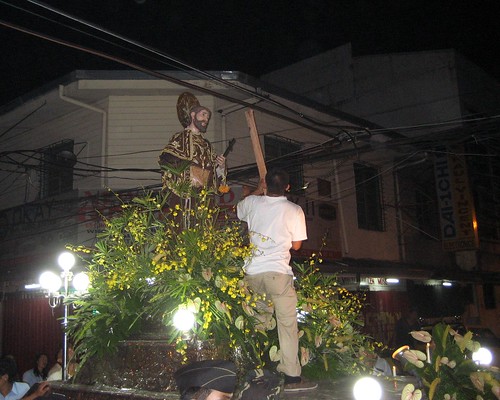 A handler for Senor San Jose’ carriage dealing with the low hanging wires with a pole.
A handler for Senor San Jose’ carriage dealing with the low hanging wires with a pole. St. Ignacio de Loyola was the tallest; a handler had to stand beside the image to lift the wires.
St. Ignacio de Loyola was the tallest; a handler had to stand beside the image to lift the wires. Our Lady of the Pillar carriage was at the end of the grand procession.
Our Lady of the Pillar carriage was at the end of the grand procession. Devotees at the grand procession.
Devotees at the grand procession.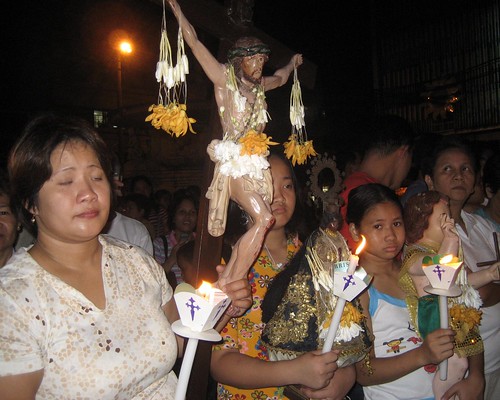 Some folks brought along their idols of worship from home to join the procession.
Some folks brought along their idols of worship from home to join the procession.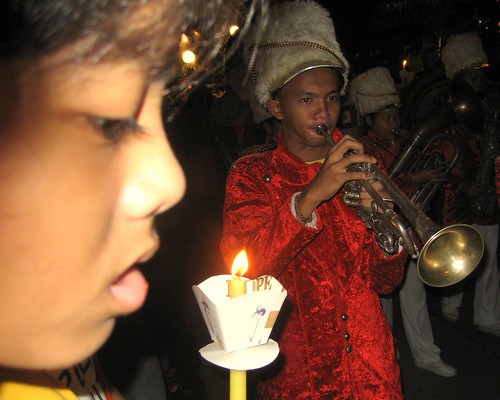 The band of young musicians’ rendition of Ave Maria was quite awe-inspiring.
The band of young musicians’ rendition of Ave Maria was quite awe-inspiring. Congressman Mark Jimenez handed out free rosaries to the crowd.
Congressman Mark Jimenez handed out free rosaries to the crowd.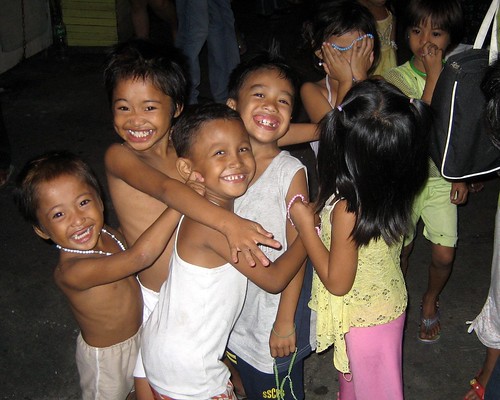 The most joyful bunch from the entire crowd of onlookers.
The most joyful bunch from the entire crowd of onlookers.
posted by Señor Enrique at 3:53 PM
| 15 comments
![]()
![]()

Saturday, October 14, 2006
GENERAL CARRIEDO AND FR. HUERTA
 This weekend marks the second week I am without phone service; the longest in my adult life I had gone without such basic convenience.
This weekend marks the second week I am without phone service; the longest in my adult life I had gone without such basic convenience.I really shouldn’t complain since there are those harder hit like the businesses in the area, unable to process any credit card transactions without a landline.
Notwithstanding, what’s more irksome is that no one in the PLDT organization can provide any reason for this loss of phone service. Neither is there anyone with any idea as to when the service might be fully restored. The only thing an affected subscriber can do is wait.
And as if that weren’t bad enough, right after the Milenyo typhoon, the city had started their drainage improvement project in the neighborhood. It’s all good, except for one thing, the ditch diggers had discovered a busted water pipe (or so they claim) that leads to the house. Although duly advised, NAWASA, the local water service provider is yet to send a repair crew to fix it despite my repeated calls to their call center and visits to their offices. Problem is the contractor has a deadline to meet; whether NAWASA fixes the pipe or not, the contractor will have to pour cement to seal the new drainage system; chances are, the inflow of water into our house might get interrupted if sealed without the busted pipe having been repaired.
On Wednesday, I once again visited the NAWASA office; this time I was assured by one of its chief engineers that a service crew would be dispatched the next morning. To date, no one has shown up. Unbelievable!
 Speaking of water service, more than two hundred years ago, General Francisco Carriedo y Peredo — the Spaniard in which the popular street was named after (where the original ShoeMart Store once stood) and the water fountain that adorns Plaza de Sta. Cruz — bequeathed P10,000 in 1743 as an initial endowment for the creation of the first water system in Manila to provide free water for the poor in perpetuity.
Speaking of water service, more than two hundred years ago, General Francisco Carriedo y Peredo — the Spaniard in which the popular street was named after (where the original ShoeMart Store once stood) and the water fountain that adorns Plaza de Sta. Cruz — bequeathed P10,000 in 1743 as an initial endowment for the creation of the first water system in Manila to provide free water for the poor in perpetuity.Entrusted to the Obras Pias, this sum of money was to accumulate in the Galleon Trade until it should grow by way of profits and interest into a sufficient fund to build a water system.
Unfortunately, in 1762, an iron chest with P250,000 and labeled Fondo de Carriedo was among the spoils carted off by the invading British forces when it looted the city. Consequently, buried under tons of governmental archival documents, General Carriedo’s will was forgotten until a Franciscan friar, Fr. Felix Huerta began the search, found the documents and calculated that by 1878, the sum had grown to P177,853.44. Fr. Huerta spearheaded the efforts in actualizing the wish of General Carriedo, and within four years the water system was completed at a total cost of P742,509. With 153 hydrants, the system was inaugurated on August 23, 1882.
Incidentally, with the reputation and integrity of the friars in the 19th century Philippines suffering a severe blow from the outright scandalous wrongdoings by some members of the frock, almost buried under such heap were the valuable contributions of Fr. Felix Huerta. He was close to being forgotten despite the honor he brought to both his order and to the priesthood.
Fr. Huerta, as administrator of San Lazaro Hospital in 1859, worked tirelessly to have this charitable institution for lepers reconstructed when it was threatened with closure. It was also during this time that Fr. Huerta was said to have searched 300 government records (government archives existed since the beginning of the Spanish regime, for which we owe the existence of the 11 million documents in the National Archives) and discovered the Carriedo fund for the construction of a water system to provide free water for the poor of Manila.
It was also Fr. Huerta who managed to convince the Archbishop of Manila and the government to establish Monte de Piedad. The friar’s intention was to provide a savings bank for the city’s poor that would charge moderate interest rates.
A street in Sta. Cruz, Manila, was named in honor of this indefatigable Franciscan friar whose integrity was unblemished and beyond reproach.

*
posted by Señor Enrique at 4:40 PM
| 15 comments
![]()
![]()

Thursday, October 12, 2006
AVENUE THEATER: END OF AN ERA





posted by Señor Enrique at 5:31 PM
| 7 comments
![]()
![]()

Tuesday, October 10, 2006
RENEGADOS AND THE AGRARIAN UPRISING
 Besides the Philippine Military Academy (PMA) in Baguio City, the Philippine College of Criminology (PCCr) in Quiapo, Manila, may be one of the largest schools in the country that churns out candidates for the Philippine National Police (PNP). Great if the true intention is to protect and serve the citizenry; unfortunately, there are those who sign up simply for the sense of power it brings and the lure of illegal money to be made on the side.
Besides the Philippine Military Academy (PMA) in Baguio City, the Philippine College of Criminology (PCCr) in Quiapo, Manila, may be one of the largest schools in the country that churns out candidates for the Philippine National Police (PNP). Great if the true intention is to protect and serve the citizenry; unfortunately, there are those who sign up simply for the sense of power it brings and the lure of illegal money to be made on the side.The jueteng alone can provide immense revenue streams not only for law enforcement officials, but for politicians as well. This two-number game that can be played with a minimal bet is the country’s most popular illegal game. Many may frown upon it as a poor man’s game, but add up all the bets nationwide and the total can reach to billions of pesos a month. And to keep the game going unhindered, jueteng lords — or the illegal gambling syndicate — allocate enormous “franchise fees” to their respective region’s high-ranking police and various government officials, which can easily run up to several millions. On its very top tier is usually a regional PNP director who may receive P1 million a month and the provincial police chief P500,000. This may very well be the reason why this illegal game could never be eradicated from Philippine society.
Ecclesiastical organizations in the Philippine archipelago, especially during the Spanish era, were not immune from such renegades in their rank and file, either. In fact, their most brazen, insidious act provoked the Agrarian Uprisings of 1745-46, which precipitated the numerous deaths of Filipinos. And although they occurred outside of Manila — Bulacan, Batangas, Laguna and Cavite — the cases were tried in Manila.
The insurrections were basically instigated by the usurpation of Filipino-owned lands by certain religious orders. Their ecclesiastical assertion — God created the world; therefore, those who represent God have first option to claim ownership to its land mass — befuddled the heck out of the Filipinos who refused to willingly hand over their ancestral lands to the church. But the friars relentlessly held on to their illegal claims and cursed the Filipinos with the wrath of God for their recalcitrance.
And so in September 1745, the Filipinos were so agitated by the friars that the first series of uprising occurred in the Jesuit estates of Lian and Nasugbu in Batangas province. It was the Filipinos’ initial attempt to recover the lands which they considered to be their birthright. They were so enraged by the audacity of the friars for treating them like mindless infantile that as revenge, they plundered and burned the Jesuit convents, devastated the ranches, looted their wine cellars, and chased them out of town. The uprising gathered momentum and spread to neighboring provinces, but Spanish troops were sent to quell the massive disturbance by executing their leaders and diehard followers. Those who surrendered were pardoned and sent back to their farming chores. Subsequently, the friars returned to rebuild and restore their profitable farming enterprises.
However, news of these agrarian conflicts reached the court of King Philip VI who immediately appointed Oidor Pedro Calderon Enriquez to investigate the charges brought against these religious orders and to ascertain the validity of their claims to the lands in questions. The friars vehemently refused to show any documentation or titles when demanded upon by a secular judge; they declared ecclesiastical immunity and reminded the court that they were, technically, God personified, and therefore above and beyond the law of man. Naturally, the governor general finally had enough of their foolishness. With his patience exhausted, he dispossessed the friars of the lands which they had grabbed illegally from their rightful owners.
However, much to the dismay of the Filipino land owners, their lands were not returned to them; they were restored to the Crown. The rightful Filipino owners were in no position to question or challenge the court of King Philip VI; hence they perceived this cruel twist of fate as the actual wrath of God as cursed upon them by the friars.
And now without any farmlands and nothing else to do with their free time, the friars launched concerted efforts to reclaim the Filipino-owned lands. They first appealed their case to the Royal Audiencia of Manila, but its tribunal upheld the first decision. Undeterred, the friars shipped off their legal dream team to Spain to appeal their position to the Council of the Indies in Madrid; it was again dismissed with the original decision upheld.
The friars proved adamant and headstrong. Eventually, their sheer tenacity and complete disregard of the law wore out the officials in Spain; they found sympathetic ears and consequently won their case, which gave them ownership to those vast tracts of disputed lands. Furthermore, such ownership remained intact even after the end of the Spanish regime. It was a victory that defied the basic tenets of morality and righteousness.
There is, indeed, a fine line between good and evil, and for the renegades, who crossed it, it can be said then that crime does pay not only for some crooked police officials and syndicate crime bosses, but for the men of the cloth as well.
posted by Señor Enrique at 1:29 PM
| 15 comments
![]()
![]()



